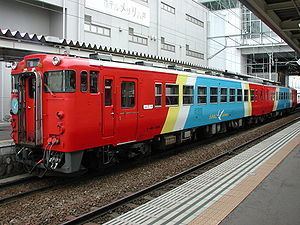Type Heavy rail Line length 64.9 km (40.3 mi) Electrification None | Opened 1894 Track gauge 1,067 mm (3 ft 6 in) Termini Hachinohe Stations 25 | |
 | ||
Japan visual clip series jr hachinohe line
The Hachinohe Line (八戸線, Hachinohe-sen) is a railway line in the Tohoku Region of Japan, operated by East Japan Railway Company (JR East). It links Hachinohe Station in Hachinohe, Aomori with Kuji Station in Kuji, Iwate. The line stretches 106.9 km along the Pacific Ocean coast with a total of 25 stations. The section between Hachinohe and Same stations is also known as the Umineko Rail Hachinohe-Shinai Line (うみねこレール八戸市内線). The Hachinohe Line is operated by East Japan Railway Company (JR East).
Contents
- Japan visual clip series jr hachinohe line
- 40 jr east hachinohe line kiha40 series dmu
- Basic data
- Stations
- Rolling stock
- History
- 2011 Thoku earthquake and tsunami
- References
40 jr east hachinohe line kiha40 series dmu
Basic data
Stations
Rolling stock
In November 2014, JR East announced that it was tendering for the procurement of a fleet of new diesel multiple unit (DMU) trains for the line to be delivered in 2017. The planned fleet will consist of six single-car units and six two-car units (19 vehicles in total).
History
The first line to Hachinohe was opened in 1891 by the Nippon Railway Co., which connected Ueno in Tokyo with Aomori in Aomori Prefecture. This line later became the Tōhoku Main Line. However, the route bypassed the centre of Hachinohe.
In 1894, a spur line connecting Shiriuchi (now Hachinohe) on the Tōhoku Main Line with Hachinohe (now Hon-Hachinohe was completed. This line was soon extended south to the now-defunct Minato Station. After the nationalization of the Nippon Railway in 1907, the spur line was renamed the Hachinohe Line in 1909. From 1924, the line's name was written with its current characters, and the southern terminus of the line was extended to Taneichi in Iwate Prefecture. The following year it reached Rikuchū-Yagi, and in 1930 it reached its present southern terminus of Kuji where it connected to the Sanriku Railway Kita-Riasu Line, which links Kuji with Miyako in southern Iwate. Freight operations were phased out at most stations between 1982 and 1986.
With the privatization of the Japanese National Railways (JNR) on April 1, 1987, the Hachinohe Line came under the control of the East Japan Railway Company (JR East), with remaining freight operations transferred to the Japan Freight Railway Company (JR Freight) at Hachinohe Freight Terminal.
When CTC signalling was commissioned on the line in 2006, it replaced the last mechanical semaphore signals on the JR network, at Rikuchuyagi station.
2011 Tōhoku earthquake and tsunami
The line was damaged by the 2011 Tōhoku earthquake and tsunami on March 11, 2011, and services were suspended on the section between Taneichi and Kuji, with a number of vehicles trapped at Kuji Station. Services over the entire line resumed on March 17, 2012.
